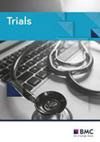高频磁成对联刺激促进缺血性中风患者的运动功能恢复:单中心假刺激随机对照试验(H2MPAS)研究方案
IF 2
4区 医学
Q3 MEDICINE, RESEARCH & EXPERIMENTAL
引用次数: 0
摘要
大量研究已经验证了电磁配对相关刺激的临床有效性。在此基础上,我们开发了一种新方法,即高频磁配对相关刺激法,旨在增强临床适用性并提高潜在疗效。然而,这种方法的临床疗效仍不明确。我们的目标是通过采用高频配对来干预中风后出现运动功能障碍的患者,从而证明这种新方法的治疗效果。这是一项涉及中风后上肢运动功能障碍患者的单中心、单盲、假刺激对照临床试验。干预措施采用配对磁刺激,结合外周磁刺激和中枢磁刺激,适用于布鲁恩斯特罗姆 III-V 期中风患者,持续时间为 3 个月至 1 年。干预前和干预 3 周后对患者的上肢运动功能进行评估。干预 5 周和 3 个月后将进行随访。主要测量结果是行动研究臂测试,次要测量结果包括福格-迈耶评估-上肢、改良巴特尔指数、改良塔迪厄量表、功能性近红外光谱和神经电生理学。本研究中使用的高频磁场配对联想刺激结合了高频磁场刺激和配对刺激,既能通过高频刺激促进大脑皮层兴奋,又能通过配对刺激增强特定回路。随着双线圈磁刺激设备的日益普及,磁-磁配对关联刺激可为患者提供更好的临床疗效,同时降低成本。中国临床试验注册中心,ChiCTR2400083363。注册日期:2024 年 4 月 23 日。本文章由计算机程序翻译,如有差异,请以英文原文为准。
High-frequency magnetic paired associated stimulation promotes motor function recovery in ischemic stroke patients: a study protocol for single-center, sham stimulation randomized controlled trials (H2MPAS)
Numerous studies have validated the clinical effectiveness of electromagnetic pairing-associated stimulation. Building upon this foundation, we have developed a novel approach involving high-frequency magnetic paired-associated stimulation, aiming to enhance clinical applicability and potentially improve efficacy. However, the clinical effectiveness of this approach remains unclear. Our objective is to demonstrate the therapeutic efficacy of this novel approach by employing high-frequency pairing to intervene in patients experiencing motor dysfunction following a stroke. This is a single-center, single-blind, sham stimulation controlled clinical trial involving patients with upper limb motor dysfunction post-stroke. The intervention utilizes paired magnetic stimulation, combining peripheral and central magnetic stimulation, in patients with Brunnstrom stage III–V stroke lasting from 3 months to 1 year. Evaluation of patients’ upper limb motor function occurred before the intervention and after 3 weeks of intervention. Follow-up visits will be conducted after 5 weeks and 3 months of intervention. The primary outcome measure is the Action Research Arm Test, with secondary measures including the Fugl-Meyer Assessment-upper, Modified Barthel Index, modified Tardieu scale, functional near-infrared spectroscopy, and neuroelectrophysiology. The high-frequency magnetic paired associative stimulation used in this study combined high-frequency magnetic stimulation with paired stimulation, potentially facilitating both cortical excitation through high-frequency stimulation and specific circuit enhancement through paired stimulation. As dual-coil magnetic stimulation equipment becomes increasingly popular, magnetic-magnetic paired associated stimulation may offer patients improved clinical outcomes at reduced costs. Chinese Clinical Trial Registry,ChiCTR2400083363. Registered on 23 April 2024.
求助全文
通过发布文献求助,成功后即可免费获取论文全文。
去求助
来源期刊

Trials
医学-医学:研究与实验
CiteScore
3.80
自引率
4.00%
发文量
966
审稿时长
6 months
期刊介绍:
Trials is an open access, peer-reviewed, online journal that will encompass all aspects of the performance and findings of randomized controlled trials. Trials will experiment with, and then refine, innovative approaches to improving communication about trials. We are keen to move beyond publishing traditional trial results articles (although these will be included). We believe this represents an exciting opportunity to advance the science and reporting of trials. Prior to 2006, Trials was published as Current Controlled Trials in Cardiovascular Medicine (CCTCVM). All published CCTCVM articles are available via the Trials website and citations to CCTCVM article URLs will continue to be supported.
 求助内容:
求助内容: 应助结果提醒方式:
应助结果提醒方式:


